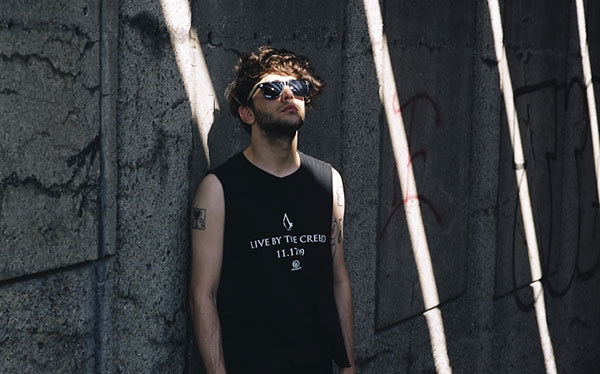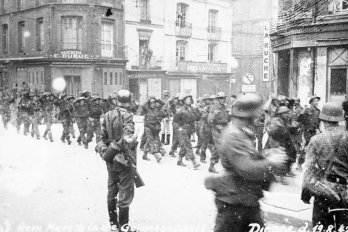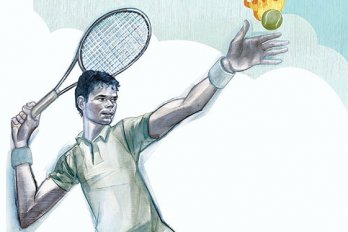It is Sunday morning at an art deco bar in Montreal. The venue is packed with movie extras wearing outfits that scream gaudy ’80s excess. Melvil Poupaud, a well-known French actor in his late thirties, slouches at the bar in a baggy linen shirt patterned in pastel foliage. His fortyish Québécoise co-star, Suzanne Clément, sits across from him in a rainbow blazer, knit tank top, and chunky gold pumps. Between them stands Xavier Dolan, their upstart twenty-three-year-old director.
In Laurence Anyways, the third film of Dolan’s short career, Poupaud plays Laurence Alia, a high school teacher who undergoes gender reassignment surgery. During the scene at hand, Laurence tells his brash girlfriend, Fred (Clément), that he plans to have a sex change but does not want to leave her. It’s an emotionally difficult moment, and the director struggles to get it right. Over five hours of repetitive takes, he requests tiny modulations in how the actors sit, speak, and look at each other.
Dolan is slight and disarmingly handsome, with high cheekbones and a hairstyle somewhere between a box top and a rat’s nest. Although known for his impeccable style (he wore a stovepipe hat and an embroidered jacket to a recent Vogue photo shoot), he dresses inconspicuously on set, today in slim black pants and a burgundy T-shirt. He lacks the wizened authority of a veteran filmmaker but compensates with enthusiasm. At one moment, he confers with the grips about set-up; an instant later, he holds a hushed conversation with his line producer; then he engages in a prolonged embrace with Clément.
It’s fall 2011, and Quebec’s young people have formed an increasingly dynamic and powerful presence. Six months earlier, they cast their votes in a federal election, in which they presided over the ascendance of an eclectic, fresh-faced NDP caucus. Six months later, they will take politics beyond the ballot box, through a tireless student protest against tuition hikes and economic austerity. This generation is proudly Québécois, but with a cosmopolitan strain that has given rise to such celebrities as Karine Vanasse, a star of local cinema and American television; and Ariane Moffatt, a bilingual pop singer who has performed at the South by Southwest festival in Austin, and at the Shanghai World Expo. As one of Québécois cinema’s most promising new talents, Dolan embodies the energy and aspirations of this moment. But as an artist, he remains beholden to his own vision and ideals.
Like Sofia Coppola, Jason Reitman, and other filmmakers who found success early on, Dolan grew up in the industry. As a child actor, he earned a small fortune from appearances in movies, and in a series of ads for the Jean Coutu pharmacy chain. But in the early 2000s, his acting career had faded into non-existence, and his academic life followed suit. Sometime during his early adolescence, he realized he was gay.
By seventeen, he had dropped out of school, lived alone, and nourished himself on stacks of rented DVDs. Nonetheless, in that same year he emerged with his first screenplay, J’ai tué ma mère ( I Killed My Mother ), about the embattled relationship between a gay teenager and his socially conservative mother. He sank $150,000 of his own money into the production—not insignificant for a teenager, but still insufficient. To make up the difference, he peddled his screenplay shamelessly, exploiting connections and showing up unannounced at industry events. In the end, he received government financing and “love money” from family and friends, and borrowed houses to serve as sets. The actors, including his formidable female lead, Anne Dorval, accepted substandard wages; and when the production made it to the Cannes Film Festival in 2009, producer Carole Mondello maxed out her credit card to send the cast overseas. (The film went on to win three prizes, including the prestigious CICAE Art Cinema Award.)
Clément, who had a small role in J’ai tué ma mère , remembers when the intrepid teenage Dolan approached her at an industry party. “I was living a life that was more settled than I wanted it to be,” she says. “I was drawn to this person. He represented something important to me.”
During the filming of Laurence Anyways, Poupaud also found himself under the young filmmaker’s spell. “Working with Xavier is challenging,” he says. “You like him, you love him, and sometimes you feel like you’d be sad to disappoint him. People working with him feel that pressure. They want to do the best they can, and they’re frightened to be wrong.”
I first met Dolan at a restaurant in Montreal’s Mile End, while he was working seven days a week on Laurence Anyways. In person, he comes across as friendly, animated, and restless. He spills an open sugar packet into my lap, then apologizes profusely and asks to go out for a smoke. Afterwards, we head to his empty, dimly lit studio, where he will spend his Saturday behind the editing table.
Our conversation turns to ambition, a topic about which he has much to say. We discuss American director Terrence Malick’s The Tree of Life , a 139-minute epic that combines a Texas family melodrama with CGI-enhanced meditations on the cosmos and prehistory. “Pretension is the state you’re in when you fail to accomplish what you set out to,” Dolan says. “Terrence Malick never failed to tell us the story of life. Never did he fail. So he’s not pretentious; he’s ambitious.”
While Dolan reveres Malick’s big-budget mysticism, he resents the humble parochialism of his own artistic milieu. “At the Oscars, people onstage say, ‘I come from a small town where people dream big,’ ” he says. “Well, you know what? I come from a big town where people have no dreams at all.”
Insularity is just a fact in Montreal, a small market for filmmaking. Three years ago, the father-son cop comedy De père en flic returned more than $10 million at the box office, making it the highest-grossing French-language movie in Canadian history. But the success of the hammy buddy adventure portends nothing for art house directors. Jean-Marc Vallée’s acclaimed 2005 film C.R.A.Z.Y., which came within $609,000 of recouping its budget through domestic sales, represents the upper limit of what art cinema can accomplish at the Canadian box office. With figures like these, it is no wonder some Québécois directors remain timid in their ambitions and pragmatic in their spending.
Dolan, on the other hand, prefers grandiosity. For Laurence Anyways , which he also wrote, he worked with a budget of $9.5 million, over a fifty-five-day shoot. The story follows his characters from the late ’80s to the brink of the new millennium. Making such an expansive film meant paying to line the streets with ’90s-era coupes, and haggling with record executives over music rights.
“I’m going for everything with this film,” he says. “I want spectacle. I want to fucking splash the world.”
Dolan’s first two aesthetically accomplished films strained against their limited means. J’ai tué ma mère might be categorized as social realism, except it intersperses the starker scenes of domestic discord with sepia-toned dream sequences and neatly choreographed still life montages. Sixteen-year-old Hubert and his mother, Chantale, pick at each, but their acrimony hides an intense codependent relationship. While Chantale is not necessarily homophobic, she feels confused about what it means to have a gay son, and Hubert is hopeless at making her understand. Nobody denies that the story is semi- autobiographical, least of all Dolan, who plays the lead; or his mother, Geneviève, who introduced herself to me as “la femme assassinée” (the assassinated woman).
Dolan’s follow-up, Les amours imaginaires ( Heartbeats ) depicts an awkward, flirtatious relationship between a gay man, Francis (played by Dolan); his female best friend, Marie; and a sexually ambiguous third named Nicolas. As the vapid, droopy-eyed Adonis, Nicolas acts as the perfect blank onto which Francis and Marie project their fantasies. In Les amours , Dolan opts for tinted lenses, macro shots that reveal body hair in vivid detail, and awkward kisses where the faces come together painstakingly, like docking cargo ships. According to the director, Les amours is not a love story, but rather a meditation on how the experience of love makes people self-conscious, narcissistic, and indulgent. (Appropriately, it is a self-conscious, narcissistic, indulgent movie.)
In the late ’50s, Québécois auteur Michel Brault called for “une caméra qui écoute” (a cinema that eavesdrops), heralding a tradition so realistic and austere that it hardly feels like cinema at all. Over time, directors grew obsessed with Québécois identity, which they situated in small gestures, modest lives, and colloquial speech. In Claude Jutra’s Mon oncle Antoine—where village culture centres on the church, the general store, and the clapboard social club—two young troublemakers run the local anglophone boss out of town by joyously pelting him with snowballs. And in Brault’s Les ordres , a gritty docudrama about the October Crisis, political prisoners demand that their wardens switch the radio to a francophone station.
In 1992, Jean-Claude Lauzon’s Léolo , an abject magic realist story about urban poverty, broke this mould. Since then, a handful of directors have pushed Québécois cinema toward the playful and the absurd. Robert Lepage makes cynical films about self-loathing masculinity, but they always incorporate his pet curiosities, which include space exploration and Eastern mysticism. A talking fish narrates Denis Villeneuve’s Maelström , and Manon Briand’s La turbulence des fluides takes place in a remote town under the control of transcendental cosmic forces.
Still, few Québécois directors have challenged traditional aesthetics as stridently as Dolan has. He tells stories without deference to political dogma, realism, or humility, interspersing his narratives with flights of fancy, which grow increasingly expensive with each new production. Laurence Anyways includes a dance club scene that could have been filmed at New York’s Waldorf-Astoria, and a bacchanalian feast attended by couture-clad diners. “Cinema gives me an opportunity to take revenge on boring real life,” he explains.
While his movies are colourful and sexy, they are not utopian. J’ai tué ma mère contains a disturbing scene of homophobic violence, based on Dolan’s own experience. And Laurence Anyways delivers an unflinching appraisal of individual freedom and its limits. After Laurence transitions to her true gender identity, Fred oscillates between desire for a “normal” life and infatuation with her partner. In the end, she cannot commit to either. Laurence finds that she can finally relate to the figure in the mirror—at the cost of her job, her livelihood, and eventually Fred. Dolan’s films may take place in a hyper-stylized cinematic paradise, but within that domain lingers the spectre of loss and violence.
After the 2011 federal election, Chantal Hébert of the Toronto Star wrote about the “Arcade Fire generation,” a cohort that is socially progressive and distinctly Québécois, but also attuned to global currents and unburdened by the divisive political questions that dogged their parents. At the time, Dolan’s movies—with their libertarian ethic, flamboyance, and international appeal—fit that zeitgeist perfectly. Then the Arcade Fire generation staged the largest mass demonstration in Canada’s history.
In April, Laurence Anyways earned Dolan his third invitation to Cannes. Soon after, he appeared on TVA‘s morning news program, where he lamented that his film had been relegated to the festival side program, Un Certain Regard. He also acknowledged the burgeoning student movement and its de facto leader, Gabriel Nadeau-Dubois, spokesperson for the activist organization CLASSE. “I would like to say first and foremost that Gabriel Nadeau-Dubois is doing an amazing job,” he said. “He is very articulate, and he has impressed me a lot. But also I find (and this is entirely unimportant) that he’s very sexy.” Dolan’s comments affirmed those attributes he prizes most—competence and aesthetics—and gave a playful, apolitical endorsement of modern-day Quebec’s most politicized public figure.
I met with Nadeau-Dubois in June, at a coffee shop in Montreal’s gay village. He had just returned from Quebec City, where he had attended another round of failed negotiations. The charismatic twenty-two-year-old cannot walk ten paces without being interrupted by supporters, but unlike Dolan he comes across more as a functionary than a grandstander. For him, the movement’s greatest success has been its broadening of the political conversation in Quebec: “People are tired of hearing the argument that ‘in the rest of Canada, they have unbelievable tuition fees, so that’s normal, and we should join them.’ ” He envisions a future Quebec that rejects other norms, such as economic polarization and austerity. The students’ willingness to favour imagination over business as usual makes this moment so fertile and exciting, which is surely why the movement appeals to Dolan, whose movies wage war on “boring real life.”
At Cannes—where Laurence Anyways won the Queer Palm for best LGBT-themed film, as well as an acting award for Clément— Dolan and his fellow cast members posed for countless photographs, wearing the student movement’s emblematic red square. During a phone conversation two weeks later, he spoke about his belief in accessible education, and his disgust at Bill 78, the new law that enforces restrictive permits for protests. Beyond these issues, he hesitates to speak too much about politics. Ultimately, he is more aesthete than activist, driven by personal rather than collective freedom. Cinema is to Dolan what the city streets are to his peers: a place to imagine other worlds and ways of living.
A few weeks after finishing Laurence Anyways , Dolan got cold feet about the coming-out scene in the bar. “It was over-written; it wasn’t spontaneous enough,” he says. Other directors might have hesitated about the expense and effort of reshooting a scene, and of bringing Poupaud back to Montreal from France, but that is just what Dolan did.
Instead of the staid confession at the bar, Laurence comes out to Fred in a car wash, where the clunky machinery almost drowns out his words. The scene ends early, so audiences see the conversation but not the revelation itself. Laurence’s off-screen declaration makes the decisive gesture that sets the story in motion. The build-up is manic, spontaneous, and beautifully filmed. It was the final touch Dolan needed to finish his movie.
This appeared in the September 2012 issue.




